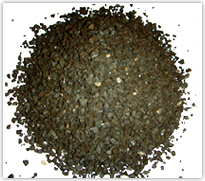Menafee Humate

What are Humates?
They are highly biodegraded and compressed remains of ancient plant and animal materials. Simply put, they are the highly decomposed organic materials that have fossilized over a period of millions of years. They are also referred to as “humic substances” and are used as soil conditioners, soil supplements, and fertilizer amendments.
How do they work?
1. They provide an available long chain carbon material to the soil structure. Carbon is a basic element for all life forms. This carbon matrix thus promotes enhanced soil microbial activity for both indigenous bacteria and those added to the soil, especially michoriza. This aids in the formation of a balanced soil structure for proper plant development. It also is an aid to decomposition of residual plant material, especially thatch.
2. They provide a full spectrum of organic acids that are essential to plant development. Specifically, these include humic and fulvic acids. These act as organic “chelators” which enhance the uptake and utilization of vital plant nutrients contained in both organic and conventional fertilizers. Due to their negative ionic characteristics, these organic acids increase the cation exchange capacity of the soil, which enhances the transfer of nutrients through cell membranes of plant root materials.
What do they do?
Used in conjunction with a balanced fertility program, quality humates will (a) enhance the overall performance of the fertilizers to a point that an actual reduction of basic N-P-K per 1,000 square feet may be appropriate over time; (b) enhance the development of root systems (michoriza); (c) enhance success of seed germination and overall plant development; (d) enhance overall plant health, resistance to stress, and appearance.
How to determine the best source of humates to use?
Years of university and field research has found that the best source of humates are those that are mined from freshwater deposits, generally found in New Mexico. These geological materials are composed of a sand matrix, contain freshwater diatoms, and have a salt content of less than 0.5%. They also have a very consistent level of humic acids.
How much to use and when?
A general rule is 100 to 250 pounds per acre or 5 to 10 pounds per 1,000 square feet per application. Depending on the area being treated, the soil analysis, the level of fertility used in conjunction with the humate, and the frequency of application will determine the exact rate of application. These products should be incorporated into normal application schedules with normal fertilizers and equipment.
John Lown is the founder of Menefee Mining Corporation and Earthgreen Products Inc., Dallas, Texas. He has been involved with and funded extensive research and product development of humates and humic substances since 1990.
They are highly biodegraded and compressed remains of ancient plant and animal materials. Simply put, they are the highly decomposed organic materials that have fossilized over a period of millions of years. They are also referred to as “humic substances” and are used as soil conditioners, soil supplements, and fertilizer amendments.
How do they work?
1. They provide an available long chain carbon material to the soil structure. Carbon is a basic element for all life forms. This carbon matrix thus promotes enhanced soil microbial activity for both indigenous bacteria and those added to the soil, especially michoriza. This aids in the formation of a balanced soil structure for proper plant development. It also is an aid to decomposition of residual plant material, especially thatch.
2. They provide a full spectrum of organic acids that are essential to plant development. Specifically, these include humic and fulvic acids. These act as organic “chelators” which enhance the uptake and utilization of vital plant nutrients contained in both organic and conventional fertilizers. Due to their negative ionic characteristics, these organic acids increase the cation exchange capacity of the soil, which enhances the transfer of nutrients through cell membranes of plant root materials.
What do they do?
Used in conjunction with a balanced fertility program, quality humates will (a) enhance the overall performance of the fertilizers to a point that an actual reduction of basic N-P-K per 1,000 square feet may be appropriate over time; (b) enhance the development of root systems (michoriza); (c) enhance success of seed germination and overall plant development; (d) enhance overall plant health, resistance to stress, and appearance.
How to determine the best source of humates to use?
Years of university and field research has found that the best source of humates are those that are mined from freshwater deposits, generally found in New Mexico. These geological materials are composed of a sand matrix, contain freshwater diatoms, and have a salt content of less than 0.5%. They also have a very consistent level of humic acids.
How much to use and when?
A general rule is 100 to 250 pounds per acre or 5 to 10 pounds per 1,000 square feet per application. Depending on the area being treated, the soil analysis, the level of fertility used in conjunction with the humate, and the frequency of application will determine the exact rate of application. These products should be incorporated into normal application schedules with normal fertilizers and equipment.
John Lown is the founder of Menefee Mining Corporation and Earthgreen Products Inc., Dallas, Texas. He has been involved with and funded extensive research and product development of humates and humic substances since 1990.